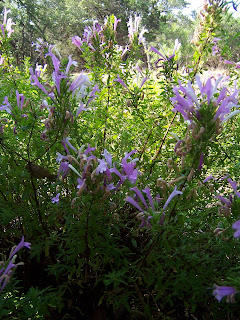Earlier this week my daughter (home sick from school - but not too sick!) and I set off to explore a dirt road that runs along our property, as part of This Grandmother's Garden's Autumn Walk Challenge. I've been wanting to traipse this road, and now I have a good excuse.
Technically, we are trespassing, which makes my daughter very nervous. The road is an easement to which we do not have access. But it washed out from flooding a year ago, and we very rarely see a vehicle navigating it. I'm sure the owners would not notice or mind two intrepid explorers.
 We crawl through our rickety bobwire fence to embark on our expedition. My daughter immediately spies these copper-colored rocks amid the usual limestone. The nice thing about walking with a child is that she has sharp eyes for things on the ground . . .
We crawl through our rickety bobwire fence to embark on our expedition. My daughter immediately spies these copper-colored rocks amid the usual limestone. The nice thing about walking with a child is that she has sharp eyes for things on the ground . . .
We head down the hill, where water drains across a low in big storms. I promptly slip on loose dirt and land - oh, so gracefully - on my rump. Only my pride injured, we continue on.
The ravages of drought (summer of 2009 and current) are quite evident. Up on top of the hill, live oak skeletons jut above dead or stressed Ashe junipers. I'm betting if the junipers are this color, they are goners. Fall color, Texas-style!
 We spy this field of rocks to our left. I'd like to come up with some clever play on "Field of Dreams" but I just don't have it in me today. I will say that we grow great rocks here in Hays County. It's our best crop.
We spy this field of rocks to our left. I'd like to come up with some clever play on "Field of Dreams" but I just don't have it in me today. I will say that we grow great rocks here in Hays County. It's our best crop. All too soon we arrive at this locked gate. I figure two locks are a pretty strong indicator that the owner is not interested in receiving visitors. We turn around.
All too soon we arrive at this locked gate. I figure two locks are a pretty strong indicator that the owner is not interested in receiving visitors. We turn around.
 My daughter points out the Ashe juniper berries, which are a lovely shade of blue. I in turn admire the interesting texture and color of some live oak deadfall.
My daughter points out the Ashe juniper berries, which are a lovely shade of blue. I in turn admire the interesting texture and color of some live oak deadfall.
Iris the dog leads the way. The road is dotted with cowpies left by Henrietta (do you remember her? She has been wandering loose on this road recently).
We pass by our property heading south toward Henrietta's home pasture, admiring our next door neighbors' well-tended, cross-fenced property - a sharp contrast to our place where nature reigns supreme. Down the way, we note the broken fence Henrietta has repurposed as a gate.
 Some might consider our next discovery gruesome, but we think it is our most interesting find: a coyote carcass. We hear coyotes frequently, but see them never. This carcass is quite desiccated and not too stinky. I suspect it may have been shot by Henrietta's owners and hung on the fence as a warning to its pack mates. "Keep out!!"
Some might consider our next discovery gruesome, but we think it is our most interesting find: a coyote carcass. We hear coyotes frequently, but see them never. This carcass is quite desiccated and not too stinky. I suspect it may have been shot by Henrietta's owners and hung on the fence as a warning to its pack mates. "Keep out!!"
A short way past this treasure, some cattle panels have been rigged to block the road. My guess is that this was done to keep Henrietta from reaching the county road (in lieu of fixing the fence!). We turn around again.
 At the corner of our property and the well-tended neighbors' is a small gap that we decide to use to get back home, just for fun. My daughter is convinced that I won't be able to squeeze through, but I do. She, of course, has no trouble.
At the corner of our property and the well-tended neighbors' is a small gap that we decide to use to get back home, just for fun. My daughter is convinced that I won't be able to squeeze through, but I do. She, of course, has no trouble.
 The original purpose of this walk was to find fall color, so we track down one fall-blooming wildflower we both adore: wood-sorrel (Oxalis Drummondii). Nearby, we spy what we think are Texas bluebonnet seedlings, germinated after our recent rains.
The original purpose of this walk was to find fall color, so we track down one fall-blooming wildflower we both adore: wood-sorrel (Oxalis Drummondii). Nearby, we spy what we think are Texas bluebonnet seedlings, germinated after our recent rains.
Home again, two happy girls after a lovely autumn walk.





























